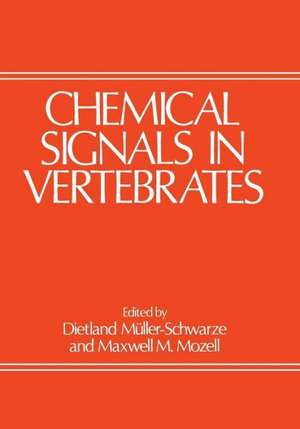Chemical Signals in Vertebrates
Editat de Dietland Muller-Schwarzeen Limba Engleză Paperback – 30 mar 2012
Preț: 663.79 lei
Preț vechi: 780.93 lei
-15% Nou
Puncte Express: 996
Preț estimativ în valută:
127.06€ • 138.06$ • 106.80£
127.06€ • 138.06$ • 106.80£
Carte tipărită la comandă
Livrare economică 21 aprilie-05 mai
Preluare comenzi: 021 569.72.76
Specificații
ISBN-13: 9781468423662
ISBN-10: 1468423665
Pagini: 624
Ilustrații: X, 610 p.
Dimensiuni: 178 x 254 x 33 mm
Greutate: 1.07 kg
Ediția:Softcover reprint of the original 1st ed. 1977
Editura: Springer Us
Colecția Springer
Locul publicării:New York, NY, United States
ISBN-10: 1468423665
Pagini: 624
Ilustrații: X, 610 p.
Dimensiuni: 178 x 254 x 33 mm
Greutate: 1.07 kg
Ediția:Softcover reprint of the original 1st ed. 1977
Editura: Springer Us
Colecția Springer
Locul publicării:New York, NY, United States
Public țintă
ResearchCuprins
One: Sources of Chemical Signals.- Structure and Function of Skin Glands.- Hormonal Control of Mammalian Skin Glands.- Bacteria as a Source of Chemical Signals in Mammals.- Chemical Attractants of the Rat Preputial Gland.- Two: Chemistry.- Properties of Compounds Used as Chemical Signals.- Chemical Methodology in the Study of Mammalian Communication.- Chemical and Behavioral Complexity in Mammalian Chemical Communication Systems: Guinea Pigs (Cavia porcellus), Marmosets (Saguinus fuscicollis) and Humans (Homo sapiens).- On the Chemical and Environmental Modulation of Pheromone Release from Vertebrate Scent Marks.- Three: Behavior:Reviews.- Chemical Communication in Amphibians and Reptiles.- Chemical Signals in Agonistic and Social Behavior of Rodents.- Pheromonal Influences on Rodent Agonistic Behavior.- Olfaction in Relation to Reproduction in Domestic Animals.- Four: Behavior:Laboratory Studies.- Sex Pheromones in Golden Hamsters.- Chemical Signals and Primate Behavior.- A Review of Recent Psychophysical Studies Examining the Possibility of Chemical Communication of Sex and Reproductive State in Humans.- Physical and Cognitive Limitations on Olfactory Processing in Human Beings.- Five: Ecology.- Chemical Communication as Adaptation:Alarm Substance of Fish.- The Study of Chemical Communication in Free-Ranging Mammals.- Two Hypotheses Supporting the Social Function of Odorous Secretions of Some Old World Rodents.- The Search for Applications of Chemical Signals in Wildlife Management.- Six: Bioassay.- From Insect to Mammal: Complications of the Bioassay.- Methodology and Strategies in the Laboratory.- Complex Mammalian Behavior and Pheromone Bioassay in the Field.- Seven: Reception of Chemical Signals.- Functional Anatomy of the Mammalian Chemoreceptor System.- MinimumOdorant Concentrations Detectable by the Dog and Their Implications for Olfactory Receptor Sensitivity.- Processing of Olfactory Stimuli at Peripheral Levels.- Taste Stimuli as Possible Messengers.- Eight: Central Processes.- Central Processing of Olfactory Signals.- Dynamic Aspects of Central Olfactory Processing.- On the Anatomical Substrate for Flavor.- Central Processing of Odor Signals: Lessons from Adult and Neonatal Olfactory Tract Lesions.- Central Control of Scent Marking.- Author Index.














